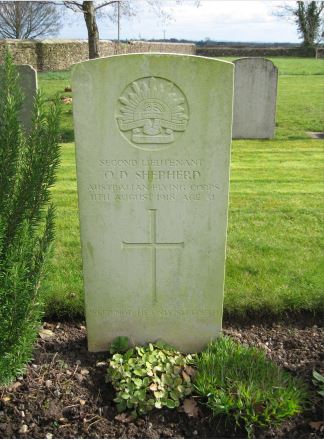6th Training Squadron, Australian Flying Corps

Oscar Dudley Shepherd was born in Goulburn, New South Wales, Australia in 1887, the son of Frederic and Anna Lauren Gibbion Shepherd, of Teneriffe, Goulburn.
His occupation at the time of enlistment was a motor driver and mechanic and on his enlistment papers he declared a conviction for ‘fast driving’. He was aged 29 years and three months when he enlisted at the Show Ground Camp, Sydney on 23 October 1916. He was assigned to the Army Service Corps as a driver and given the number 13777.
He embarked from Sydney on the HMAT Beltana (A72) on 25 November 1916, arriving in Devonport on 29 January 1917. His stay in England was brief: on 9 February he crossed the Channel from Folkestone to Boulogne on the Princess Alice and on to the Base Motor Transport Depot at Rouen, prior to joining the ‘K’ Supply Column.
From 16-19 February 1917 he was in 1st Australian General Hospital at Rouen, suffering from what was probably a mild case of influenza.
He was promoted to Temporary Corporal from 29 May to 10 July 1917 and finally left the Western Front on 7 November, joining the Australian Flying Corps (AFC) at its Halton Camp, Wendover, Buckinghamshire Depot on the 10th of that month. On 7 December he was posted to No 2 School of Aeronautics, Oxford, with the prospect of becoming a Flying Officer Pilot.
His training progressed well and on 4 April 1918 he was posted to 6th Training Squadron at Minchinhampton, initially as an Air Mechanic Second Class, Cadet. Promotion to Flying Officer Pilot and Second Lieutenant followed on 1 June 1918. He became a popular and well regarded member of the squadron: a gifted sportsman, who captained their cricket team and was a leading tennis player.
By 11 August 1918 he had logged four hours solo in the SE5a fighter. On that day he took off in one (serial no D363), from Minchinhampton Aerodrome at about 10.20am, to practise aerial gunnery. A witness to the Court of Inquiry stated that he saw Shepherd’s machine dive on a target at about 11am, travelling at around 200 mph. At a height of about 300 feet, when pulling out of the dive, a portion of the right wing collapsed, followed by the remainder of the wing unit, causing the aircraft to dive into the ground. It was believed that the aircraft pulled out of the steep dive too quickly, causing the wings to collapse under the strain. Oscar Shepherd suffered lacerations to his brain, caused by the impact with the ground and he died instantly. He was aged 31.
Second Lieutenant Oscar Dudley Shepherd was buried with military honours at Leighterton Church Cemetery at 2pm on 14 August 1918. A CWGC headstone now marks his grave.
Researched by Graham Adams February 2018
